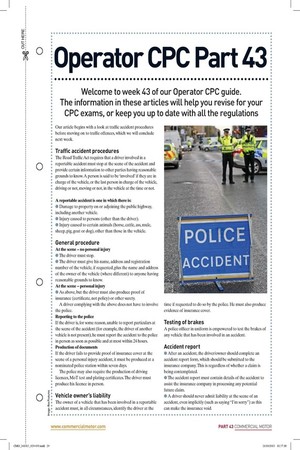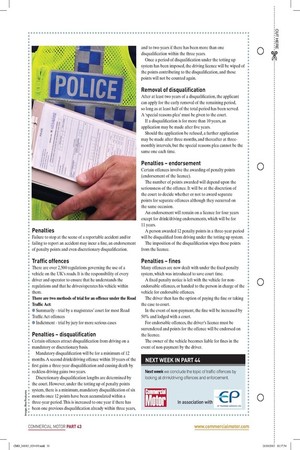Operator CPC Part 43
Page 22

Page 23

If you've noticed an error in this article please click here to report it so we can fix it.
Welcome to week 43 of our Operator CPC guide. The information in these articles will help you revise for your CPC exams, or keep you up to date with all the regulations
Our article begins with a look at traffic accident procedures before moving on to traffic offences, which we will conclude next week. Traffic accident procedures
The Road Traffic Act requires that a driver involved in a reportable accident must stop at the scene of the accident and provide certain information to other parties having reasonable grounds to know. A person is said to be 'involved' if they are in charge of the vehicle, or the last person in charge of the vehicle, driving or not, moving or not, in the vehicle at the time or not. A reportable accident is one in which there is:
• Damage to property on or adjoining the public highway, including another vehicle.
• Injury caused to persons (other than the driver).
• Injury caused to certain animals (horse, cattle, ass, mule, sheep, pig, goat or dog), other than those in the vehicle. General procedure At the scene — no personal injury
• The driver must stop.
• The driver must give his name, address and registration number of the vehicle, if requested, plus the name and address of the owner of the vehicle (where different) to anyone having reasonable grounds to know. At the scene — personal injury
• As above, but the driver must also produce proof of insurance (certificate, not policy) or other surety.
A driver complying with the above does not have to involve the police. Reporting to the police If the driver is, for some reason, unable to report particulars at the scene of the accident (for example, the driver of another vehicle is not present), he must report the accident to the police in person as soon as possible and at most within 24 hours. Production of documents
If the driver fails to provide proof of insurance cover at the scene of a personal injury accident, it must be produced at a nominated police station within seven days.
The police may also require the production of driving licences, MoT test and plating certificates. The driver must produce his licence in person. Vehicle owner's liability The owner of a vehicle that has been involved in a reportable accident must, in all circumstances, identify the driver at the
time if requested to do so by the police. He must also produce evidence of insurance cover. Testing of brakes
A police officer in uniform is empowered to test the brakes of any vehicle that has been involved in an accident. Accident report
• After an accident, the driver/owner should complete an accident report form, which should be submitted to the insurance company. This is regardless of whether a claim is being contemplated.
• The accident report must contain details of the accident to assist the insurance company in processing any potential future claim.
• A driver should never admit liability at the scene of an accident, even implicitly (such as saying "I'm sorry") as this can make the insurance void. Penalties
Failure to stop at the scene of a reportable accident and/or failing to report an accident may incur a fine, an endorsement of penalty points and even discretionary disqualification. Traffic offences
There are over 2,500 regulations governing the use of a vehicle on the UK's roads. It is the responsibility of every driver and operator to ensure that he understands the regulations and that he drives/operates his vehicle within them. There are two methods of trial for an offence under the Road Traffic Act: • Summarily trial by a magistrates' court for most Road Traffic Act offences • Indictment trial by jury for more serious cases Penalties disqualification
Certain offences attract disqualification from driving on a mandatory or discretionary basis.
Mandatory disqualification will be for a minimum of 12 months. A second drink/driving offence within 10 years of the first gains a three-year disqualification and causing death by reckless driving gains two years. Discretionary disqualification lengths are determined by the court. However, under the totting up of penalty points system, there is a minimum, mandatory disqualification of six months once 12 points have been accumulated within a three-year period. This is increased to one year if there has been one previous disqualification already within three years,
and to two years if there has been more than one disqualification within the three years.
Once a period of disqualification under the totting up system has been imposed, the driving licence will be wiped of the points contributing to the disqualification, and those points will not be counted again. Removal of disqualification
After at least two years of a disqualification, the applicant can apply for the early removal of the remaining period, so long as at least half of the total period has been served. A 'special reasons plea' must be given to the court.
If a disqualification is for more than 10 years, an application may be made after five years.
Should the application be refused, a further application may be made after three months, and thereafter at threemonthly intervals, but the special reasons plea cannot be the same one each time. Penalties endorsement
Certain offences involve the awarding of penalty points (endorsement of the licence).
The number of points awarded will depend upon the seriousness of the offence. It will be at the discretion of the court to decide whether or not to award separate points for separate offences although they occurred on the same occasion.
An endorsement will remain on a licence for four years except for drink/driving endorsements, which will be for 11 years.
A person awarded 12 penalty points in a three-year period will be disqualified from driving under the totting up system.
The imposition of the disqualification wipes those points from the licence. Penalties fines
Many offences are now dealt with under the fixed penalty system, which was introduced to save court time.
A fixed penalty notice is left with the vehicle for nonendorsable offences, or handed to the person in charge of the vehicle for endorsable offences.
The driver then has the option of paying the fine or taking the case to court.
In the event of non-payment, the fine will be increased by 50% and lodged with a court.
For endorsable offences, the driver's licence must be surrendered and points for the offence will be endorsed on the licence.
The owner of the vehicle becomes liable for fines in the event of non-payment by the driver.








































